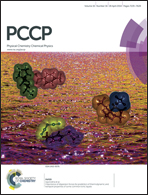Tungsten doped titanium dioxide nanowires for high efficiency dye-sensitized solar cells†
Abstract
Metal oxide semiconductors offering simultaneously high specific surface area and high electron mobility are actively sought for fabricating high performance nanoelectronic devices. The present study deals with synthesis of tungsten doped TiO2 (W:TiO2) nanowires (diameter ∼50 nm) by electrospinning and evaluation of their performance in dye-sensitized solar cells (DSCs). Similarity in the ionic radii between W6+ and Ti4+ and availability of two free electrons per dopant are the rationale for the present study. Materials were characterized by X-ray diffraction, scanning and transmission electron microscopy, X-ray fluorescence measurements, and absorption spectroscopy. Nanowires containing 2 at% W:TiO2 gave 90% higher short circuit current density (JSC) (∼15.39 mA cm−2) in DSCs with a nominal increase in the open circuit voltage compared with that of the undoped analogue (JSC ∼8.1 mA cm−2). The results are validated by multiple techniques employing absorption spectroscopy, electrochemical impedance spectroscopy and open circuit voltage decay. The above studies show that the observed increments resulted from increased dye-loading, electron density, and electron lifetime in tungsten doped samples.


 Please wait while we load your content...
Please wait while we load your content...